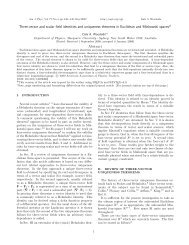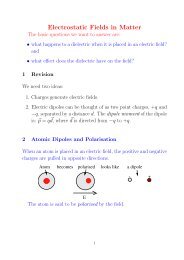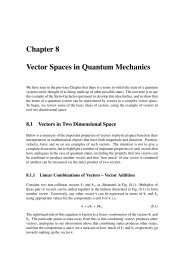AOS News - The Australian Optical Society - Macquarie University
AOS News - The Australian Optical Society - Macquarie University
AOS News - The Australian Optical Society - Macquarie University
- No tags were found...
You also want an ePaper? Increase the reach of your titles
YUMPU automatically turns print PDFs into web optimized ePapers that Google loves.
<strong>AOS</strong> <strong>News</strong> Volume 25 Number 1 20112010 Barry Inglis Medal:Professor Ken Baldwin<strong>The</strong> Barry Inglis Medal of the National Measurement Institute (NMI)acknowledges outstanding achievement in measurement researchand excellence in practical measurements in Australia. This article isa synopsis of the presentation given by Professor Baldwin on receiving thisaward at the NMI on Wednesday 21 st July, 2010.<strong>The</strong> importance of precision measurementis a hallmark of a modern technologicalsociety. Better measurement techniqueslead to new understanding of the worldaround us, which in turn leads to noveltechnological advances. <strong>The</strong> devices thatarise from new technology can furtherimprove our ability to measure precisely,and so the measurement cycle continues.<strong>The</strong>re is perhaps no better example ofthis than the measurement science whichunderpins the Global Positioning System(GPS). Each GPS satellite (Figure 1)relies on precise timing information thatis derived from its own internal atomicclock, based on the microwave frequencyof the caesium atomic ground statesplitting. This is the same transition thatsince 1967 has provided the internationaldefinition of the second:“<strong>The</strong> second is the duration of9 192 631 770 periods of the radiationcorresponding to the transition betweenthe two hyperfine levels of the groundstate of the caesium 133 atom. [...] Thisdefinition refers to a caesium atom at restat a temperature of 0 K.” [1]<strong>The</strong> adoption of a time and frequencydefinition based on an atomic transitionwas the culmination of many decades ofprecision measurement of atoms whichled to a detailed theoretical understandingof atomic structure. It is this continuinginterplay between fundamental scienceand precision measurement that yieldsmany benefits to modern society such asthe GPS.Ongoing advances in the use ofatomic frequency standards have enabledphysicists to move beyond the currentaccuracy of the Cs standard (~1 part in10 12 ). <strong>The</strong> next generation of atomic clockswill most likely be based on optical (ratherthan microwave) electronic transitions inatoms isolated in a virtually unperturbedenvironment, either in ion traps or opticallattices formed by intersecting laserbeams. This will enable accuracy at the1 part in 10 18 level – the most accuratemeasurement of any physical quantity.New areas of physics will be thrownopen for investigation as a result of thisunprecedented accuracy and precision.More rigorous tests of general and specialrelativity will be possible, and even morestringent limits will be placed on thevariation in the fundamental “constants”,which in turn will test the validity ofvarious models of the universe. And nodoubt such advances will lead to newtechnologies that may themselves furtherimprove precision, thus continuing themeasurement cycle.Central to these developments is animproved understanding of the structureand dynamics that underpins ourknowledge of atoms. This understandinghas led to the theory of quantumelectrodynamics (QED) which provides aEnergysinglets3 1 S o1 1 S o3 3 D 1232 3 P 0 122 3 S 1triplets3 3 P 012 1 S o 1083 nmtrap laser(metastable)19.8 eV electronexcitationFigure 2. Helium energy levels,showing both singlet and tripletmanifolds.2Figure 1. GPS satellite with on-boardatomic clock.near complete knowledge of atomicproperties across the periodic table. Sinceits genesis in the 1940’s, following on fromthe early advances in quantum mechanics,QED has stood the test of time and isnow one of the most rigorously validatedtheories in modern physics – thanks toprecision measurement.Considerable attention has been paidto testing QED predictions for heliumsince it is the simplest multi-electronatom, and this is where my contributionto precision measurement has been mostkeenly focused. <strong>The</strong> energy levels of heliumare shown in Figure 2 where the atomicstructure is categorised by the states forwhich the two electron spins are opposed(the singlet states) or parallel (the tripletstates). <strong>The</strong> triplet states have slower decayrates to the ground state because the spinof one of the electrons has to flip in theprocess, thus giving rise to the “forbidden”character of these transitions.<strong>The</strong> first triplet state – the 2 3 S 1state– is doubly forbidden, since quantummechanical selection rules prevent S ->S transitions. Hence its lifetime is evenlonger – around 8000 seconds – thelongest lifetime of any neutral atomic ormolecular state yet measured. This longlifetime means that the 2 3 S 1“metastable”state (as it is known) can act as an effectiveground state for transitions to the higherenergy levels in the triplet state manifold[2]. For the same reason the metastablestate cannot be readily populated by a9
















